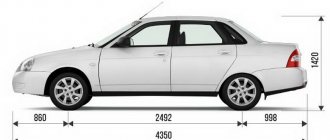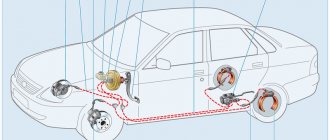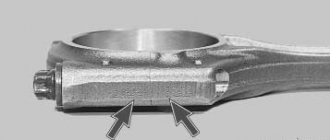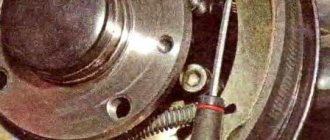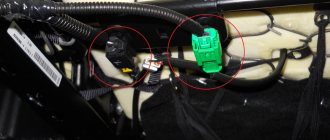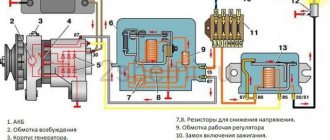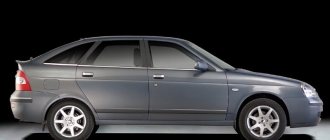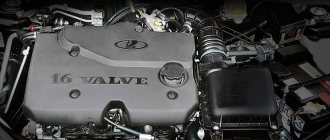The modern secondary car market in Russia is crowded. There are an incredible number of offers for selling cars, but there have been much fewer buyers in recent years. And this played a positive role in the democratization of the market, prices dropped a little and came into line with reality. Therefore, purchasing a used car has become much easier than before. Many owners of a couple of hundred thousand rubles can go to the market and buy themselves a very attractive vehicle with good characteristics and operating capabilities. Lada Priora is one of the representatives of the budget class, which is very popular in the secondary market. Today it is a classic car with quite good technology and inexpensive maintenance. And if when purchasing at a dealership you receive a guarantee and don’t have to worry about possible childhood illnesses, then in the automotive market you will have to take a serious look at the details.
When buying a used Priora, you should pay attention to many important factors of the car. In particular, the technical condition, features and damage to the body, and interior parts play a significant role. In the Russian market it often happens that buying a car for a person is a holiday and an event of a lifetime. Behind the euphoria of the purchase, the buyer often does not see minor shortcomings that greatly spoil the impression of the transport in the future. Therefore, you should choose a car with a cold mind, assessing all the shortcomings. At the very least, you will be able to ask the seller for a discount based on your findings. Also today we will talk about what to do when you finally purchased such a desired car and became the owner of a Lada Priora with a certain number of kilometers on the odometer. This is important to observe in order to enjoy the operation.
Summary data for Lada Priora (before restyling 2013)
The VAZ 2170 (this is exactly the indexing that Priora received) has an improved interior compared to the “ten”, a 16-valve engine with a volume of 1596 cc. see, and a 5-speed manual transmission in all trim levels (in the first trim levels of the sedan and hatchback with an 80 hp engine, an 8-valve engine was installed). In mixed driving mode, the Priora has 100 km. it takes from 6.6 to 7.6 liters. fuel outside the city (depending on the configuration), and in the city - 9.8 liters. The new engine allows you to accelerate to 180 km/h, and to “hundreds” in 12 seconds. This property attracts the attention of fans of high-speed racing, because by working on the engine and tuning the car, you can achieve good sports performance.
How much does Lada Priora weigh?
The weight of the car before restyling in 2013 was as follows:
- The 3-door hatchback coupe, 5-door hatchback and sedan have a curb weight (which includes the weight of a full tank of fuel and the driver) of 1088 kg. In this case, the total weight (i.e., the maximum permissible weight of the vehicle at which it can be operated after being fully loaded) is 1578 kg;
- The station wagon, with the same curb weight, is able to take a little more cargo, and its total weight reaches 1593 kg.
Thus, the station wagon is the most load-carrying of all Priora body types.
How long does a gas tank last?
With the maximum filling of the gas tank, the Lada Priora, powered by AI-95 (according to the passport!) will travel:
- 438 km in the city;
- 767 km on the highway;
- 597 km combined cycle.
However, the driving range on a full tank is given by us as a rough estimate, since depending on the configuration and modification it may vary slightly, although in all cases the volume of the gas tank is the same: 43 liters.
Cargo capacity
Cargo capacity (not payload!) of the Prior varies depending on the body type. So, trunks have different volumes:
- 360 liters – for hatchback and coupe;
- 430 liters - for the sedan;
- 444 liters - for the station wagon.
As we can see, this volume is not very different from the sedan’s, so it’s a very stretch to say that the Priora station wagon was created to solve a wide range of economic problems (relative to other variants of this car). Of course, cargo capacity increases significantly if you fold the back of the rear sofa, or even better, remove the entire rear seat.
Hatchback advantages
- Compactness
. The body has a shorter length, which makes the car more maneuverable. Such a vehicle is easier to drive in dense city traffic and easier to park. It’s no wonder that 80% of densely populated Europe has switched to hatchbacks. - Huge trunk
. The seemingly small dimensions of the car provide the car owner with a spacious luggage compartment. If you fold down the rear passenger seats, you can easily transport a refrigerator or small furniture. - Ideal for novice drivers
. In such a body, the dimensions of the car are very clearly felt, which is a significant advantage when learning to drive. It is for this reason that most driving schools have hatchbacks in their inventory. - Price
. A car that leaves the factory in such a body always costs less, but is more expensive on the secondary market. It also has greater liquidity in used condition. - The appearance of the hatchback is more sporty
, which makes it a stylish and youthful car.
Dimensions of VAZ 2170 and other modifications of Priora
The dimensions of the car are something that needs to be taken into account when purchasing, since the dimensions of parking spaces, garages, turns or entrance arches are not always universal. The height is measured from the extreme point of the front to the extreme point of the rear bumper. The width is measured at the widest point, and the height is measured from the surface of the ground to the highest point of the roof. Roof rails and racks do not fit into the height of the body. Taking this into account, the dimensions of the Priora are as follows:
- The longest body of cars in this family is the sedan. It measures 4350 mm in length. But at the same time it is the lowest - 1420 mm. in height.
- The next longest is the station wagon, with its 4340 mm length. It is the highest in height – 1508 mm.
- The five-door hatchback and three-door coupe are the shortest - 4210 mm. at 1435 mm. in height.
In all four cases, the width of the Priora is the same - 1680 mm. Ground clearance is 165 mm, although in the Priora Sport configuration it is somewhat reduced, but this is no longer so important, since this car is no longer produced in this version.
Anti-aging treatments
As soon as you start the engine, the new car’s low beam headlights flash, even if the switch is in the “0” position - convenient. The indicator squeaks to warn you that your seat belt is not fastened, and when you lightly touch the steering column, the turn signal flashes three times.
I turn on the side lights sequentially, then the headlights... Not one icon appears on the instrument panel, like in an old car, but two. It’s a small thing, but now you don’t have to guess what lighting equipment works.
The new instrument panel is more interesting in terms of design. In general, there were no special complaints about the previous one, but it was too simple and had already become familiar. And then there were the wide white arrows and well-arranged pictograms, and I immediately fell in love with the new product.
The updated dashboard not only refreshed the interior, but also added convenience. The on-board computer screen was placed in the center. There is no unnecessary beauty on the monitor, everything is simple, but large numbers are clearly visible in motion.
The driver's position is praised by many owners, but being 190 cm tall, I feel uncomfortable in the seat: there is very little space in the area of the pedal assembly of the old car, and there is not enough longitudinal adjustment of the seat. The updates have corrected the situation a little: the seat slides in the new car have been lengthened, so you don’t have to lean the back too much back.
The chair is denser, it better fixes the body in turns. The distance between the gas and brake pedals is noticeably greater. Having adjusted the driver's seats in both cars, I tried to sit back and couldn't. The backs were too close to the rear sofas. And if four people get into the car, I, the driver, will have to press my knees to my ears.
Modifications of Lada Priora until 2013
VAZ 2170 Lada Priora I generation cars have the following body options: 4-door sedan, 5-door hatchback and station wagon, and 3-door coupe. Depending on the year of manufacture and configuration, engine power may vary, which looks like this.
Engine Lada Priora 2007, sedan, 1st generation
Based on the configuration, sedans before the 2013 restyling are equipped with the following engines:
- 80 “horses”: 8 valves, maximum speed 172 km/h, gasoline consumption – 7.6 liters. for every 100 km. in a mixed cycle.
- 16-valve engine with 89 hp. reaches speeds of up to 176 km/h, consuming 7.3 l/100 km. paths in a mixed cycle. As you can see, in terms of its characteristics, this engine is not much different from its “younger brother,” although it consumes a little less gasoline.
- 16-valve 98-horsepower engine: maximum speed 183 km/h, AI-95 consumption in the combined cycle – 7.2 l/100 km.
Engine Lada Priora 2008, hatchback, 1st generation
5-door hatchbacks have been produced since 2008. Depending on the configuration, they are equipped with:
- 80-horsepower 8-valve engine, delivering the same speed and fuel consumption characteristics as in the case of a sedan equipped with the same engine;
- 16-valve engine with 89 hp, which produces the same speed for a hatchback and consumes the same amount of gasoline as a sedan with the same engine;
- A 98-horsepower 16-valve engine, thanks to which the hatchback completely matches the speed and consumption characteristics of a sedan with the same power plant.
Engine Lada Priora 2008, station wagon, 1st generation
With a station wagon everything is simpler. From the very beginning of production, it had only one, but the most powerful engine at that time, producing 98 l/s, which accelerated the car to 183 km/h and consumed 7.2 liters of gasoline per 100 km. paths in a mixed cycle. Thus, despite the large cargo capacity of the station wagon, its rated speed remains the same as that of other Priors in a different body version, but with the same engine, since the curb weight is the same for all modifications. Probably, when fully loaded, the station wagon will show slightly lower speed or higher fuel consumption characteristics.
Engine Lada Priora 2010, coupe, 1st generation
Since 2010, Priora has received another modification - a three-door coupe-hatchback. Everything with him is also quite simple, because... It is equipped with a 98-horsepower 16-valve engine, giving a top speed of 183 km/h, consuming 7.4 liters of gasoline per 100 km in the combined cycle, i.e. slightly more than all other body modifications. As you can see, the station wagon and coupe do not have such a wide engine variation as the 5-door hatchback and sedan, since cars of such a body are not designed for wide sale, but for specific needs: sports and motor tourism. By the way, the creators of Priora had the idea to launch a convertible into series, but reasonably considering that it would not find its buyer, they abandoned this idea.
Content
- Reason 1 – spark plugs
- Reason 2 - ignition coils
- Reason 3 – injectors or throttle body
- Reason 4 – fuel filter
- Reason 5 – mass air flow sensor or ECU firmware
- What to do to prevent the Priora from jerking
“Help, my Priora car is shaking while driving. What to do? What could be the problem?" – a car enthusiast wrote on one of the forums. This problem often occurs in domestic cars, and there may be several reasons for its occurrence. Let's figure out why the Priora twitches, how to solve the problem and how much it costs.
Restyling Lada Priora 2013
The 2013 restyling consisted of some changes regarding the appearance, some equipment, interior and engine. Among such changes in Prior we will name:
- A slightly modified exterior geometry, which, however, makes no sense to describe, since visually Priora before and after restyling remained almost indistinguishable in appearance;
- Replacing the radiator grille with an elongated “honeycomb”, slightly tilting the car into the now fashionable “organic” style, characterized by biological forms;
- Improved external lighting technology, thanks to which the car’s dimensions have become clearer in the dark. In particular, the area of the reflectors has been increased, LED sections for side lights and brake lights have been added, which are both brighter and more responsive when switched on;
- A dashboard that is implemented differently: instead of four “dials,” the sensor arrows were arranged in two, without compromising functionality. Purely aesthetically it looks better, but from an ergonomic point of view, a lot depends on habit;
- An increased number of pictograms flashing on the dashboard, making it easier to figure out which lighting equipment is faulty;
- An added niche in the center of the dashboard, in which the on-board computer is placed;
- Extended front seat slides, allowing tall drivers and front passengers to adjust their seat positions more flexibly;
- A box that is more spacious in depth to the right of the driver;
- A more attractive three-spoke steering wheel with an airbag under a triangular cover;
- In the “luxury” configuration – leather upholstery based on a combination of auto fabric and eco-leather;
- New door card design.
Also, since 2013, Priors have been produced in a different engine configuration, from which the 80-horsepower engine was removed, but a new 106 l/s engine was added, which, like everyone else, reaches speeds of up to 183 km/h and reduces fuel consumption to 6. 8 – 6.9 liters per hundred km. This engine is equipped with the “luxury” configurations of the Priora. Of course, such a reduction in fuel consumption is very attractive to the consumer. We can only hope that the developers will continue to work in this direction. In addition, the new engine fits well into Euro-3 and Euro-4 environmental standards, thanks to the closely located catalyst. Due to rapid heating, the catalysis of toxic substances occurs more vigorously, as a result of which a lower concentration of them enters the atmosphere.
The restyled Prior also has a drawback (compared to previous editions of this car): the carpet in the trunk is thinner than its predecessors, which is why the noise level while driving is higher. Motorists are advised to take care of additional sound insulation in the trunk. In addition, the curb weight of the car has increased (to 1185 kg), which is by as much as 100 kg. reduced its cargo capabilities, since the maximum weight remained the same - 1593 kg. for a station wagon, and 1578 kg. for other body variations.
Facelift
On the training ground we looked like children looking for differences in two seemingly identical pictures. So, looking back at the pre-restyling car, which we immediately dubbed old, we begin to bend our fingers, counting the updates. The front bumper, which appeared on the model last year, has not changed, so at first glance both Prioras appear the same.
The only difference is the plastic radiator grille - the new honeycomb structure has refreshed the exterior. Although at a distance the honeycombs still need to be seen. The headlights are the same. I agree with the opinions of the owners on numerous forums: they work as they should.
In the stern, the main focus is on the lights. Now in their lower part there are LEDs, which are longer lasting than ordinary lamps that are on a white car. Larger reflectors on the bumper also help to outline the dimensions. At dusk, the new lighting technology really showed itself better - it was noticeably brighter.
Configurations of Lada Priora VAZ 2170 and other modifications
VAZ 2170 is known in the following configurations:
- “Standard” is the most budget package. It lacks: audio radio, speakers, air conditioning, rear headrests, immobilizer, central locking, heated front seats, electric drive and heated exterior mirrors, fog lights, remote trunk release. The front windows are electric, the rear windows are mechanical. The engine is 81 hp, which has been discontinued since 2013, and at the moment there are no longer orders for this configuration;
- “Norma”, which is equipped with an 87-, and after restyling - only a 98- and 106-power engine. Available: audio preparation, on-board computer, electric heating and electric drive of exterior mirrors, immobilizer, anti-theft alarm and all the elements of the “standard” equipment plus some new equipment. This configuration is in greatest demand due to its price niche. When you need a car “yesterday”, you have to buy what you have enough money for now, and everyone else has to retrofit the car in the process.
- "Norma+". In fact, this is the same standard for which one or more items of equipment are set: air conditioning, audio radio with speakers, ABS + BAS, child seat mounts, heated front seats and windshield;
- “Lux” is the most rich in functionality. It has everything that the “norm+” has, and in addition: side airbags, an airbag for the front passenger, rear and front electric windows, a navigator, a multimedia system, cruise control, parking sensors, fog lights, a rain sensor, a climate system , alloy wheels, heated front seats;
- “Sport” is a special package that increases the “sports” component. This is an aerodynamic body kit: a pronounced bumper with a spoiler, side sills, a diffuser rear bumper, and a wing on the trunk lid. The wheels with narrow profile tires are also different. Ground clearance, curb weight (up to 1080 kg) and maximum weight (up to 1500 kg) have been reduced. The interior has also been transformed: side supports have been added along the edges of the seats with red stitched seams, carbon fiber inserts, and a leather steering wheel. Air conditioning, radio, and a full set of electric windows are included. However, the production of sports Prioras was limited and today they are discontinued, although they can be found here and there on the highway, and most often these are Priora coupes.
Of course, this is not a complete, but only an indicative overview of the configurations of the Lada Priora, which is hardly possible to present in its entirety within the confines of one article. In addition, the equipment also differs somewhat depending on the body type. For example:
- Prior station wagons have roof rails, brackets on the wheel arches of the trunk, for which cargo can be strapped;
- For the coupe body, folding backrests and a reinforced frame of the front seats have been developed.
Color change
“First impressions: the car needs to be rolled out, it doesn’t drive. There is no sound insulation, locks and door handles require improvement. The standard tires are noisy and dull. You’re riding like you’re on stumps.”
“In two difficult months, the car covered 18,000 km, but did not cause any problems. The chassis, in my opinion, is quite tolerable, the only thing is that a knock is heard in the right pillar when passing speed bumps. I came to the service, looked at it - everything is fine, they say it’s their illness. The brakes are not bad, 4"...
I compare the impressions of Moscow Prior owners with my own. The cars have the same 98-horsepower engines, so there are no fundamental differences in movement. The suspensions regularly absorb large bumps, but shake on small bumps. However, the gray car is more interesting at the level of nuances: it is more composed in corners, a little more stable on the way out, and absorbs road bumps more smoothly.
In terms of acceleration dynamics, the new and old “Priors” are practically no different from each other, while a noticeable monotonous rumble fills the interior. I remember that during our first meeting with the car they told us about improving the sound insulation. We measured the noise level in the cabin (both Prioras were shod with the standard Kama-Euro) and were surprised: the new car turned out to be not as quiet as the previous version! The reason was found in the trunk: it turned out that the carpet in the pre-restyling car was thicker.
The steering is equally uninformative, and the updated car has a sharper steering wheel only in the Lux. We are waiting for him in other modifications.
“The transmission works fine, except for first gear. I switch to lower with effort. This happened to me on all Zhiguli cars, from the “six” to the “ten,” - I continue to study the forum of Prior owners.
The white Priora has a similar behavior, but here the fifth gear is difficult to engage. I push the lever by force, and it doesn’t work the first time. In a restyled car, it is more convenient to operate the lever. New cable driven unit? Unfortunately, no: both have well-known boxes with the VAZ-2112 index, which my colleague was not enthusiastic about when he tried out the new Priora in Tolyatti. Therefore, they decided: these are the features of specific machines. I would like to believe that the better performance of the transmission is evidence of improved build quality. By the way, when the engines are idling, the gearbox levers of our pair vibrate equally strongly.
The brakes lack information content and tenacity of reactions. The mechanisms seem to be lubricated with soap: I press the pedal - and every time I am dissatisfied with the rate of deceleration. I want to push the pedal harder, but the travel is not unlimited.
I remember the “Chinese” - “Lifan-Solano” and “FAW-Oley”, which I had a chance to ride on earlier. I liked the braking performance of these budget sedans much more. I wish the replacement of the Priora that her main automotive system becomes clearer and more reliable.
Well, although our pair is not in the richest configurations, there are more than enough differences between them. But there is also a “Lux”, in which you will find a multimedia system, side airbags and a more powerful 106-horsepower engine. But even without that, the old Priora still pales in comparison to the new one. However, only a new model can correct the global shortcomings of the Priora. Completely new in design.

